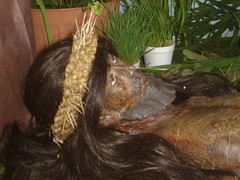
An apt piece on Good Friday festivities in a small Jalisco municipaliy published in today's Miami Herald Mexico Edition.
Tradition thrives in Jalisco village
| |
BY DAVID AGREN/THE HERALD MEXICO
El Universal
Domingo 08 de abril de 2007
SAN MARTÍN DE HIDALGO, Jal. - In the weeks preceding Good Friday, a member of the García clan lowers the family´s treasured wooden Christ statue from a cross in their home and takes the fragile figure to the local church for a special Mass, where the icon is washed and blessed.
Then, in a re-enactment of Christ lying in rest after his crucifixion, they place the 16th-century statue on a bed of laurel leaves, under the gaze of a Virgin of Dolores photo, in the front of their barrio La Flecha home.
Finally, after the local Passion Play finishes on Good Friday, the Garcías welcome hundreds of guests, who come to pay their respects.
While many Mexicans decamp the country´s cities and towns and head for the beach during Semana Santa (Holy Week), the residents of San Martín, an agrarian municipality southwest of Guadalajara, instead turn their homes into capillas (small chapels), where their Christ statues lie at rest, awaiting resurrection.
According to local priest Luis Zuñiga, "What´s represented is the moment that Jesus is being lowered from the cross" and prepared for burial.
Nobody really knows the exact origins of the tradition, which only happens in San Martín, although Malaquías García González, 77, said it dates back centuries.
His statue, named Cristo San Salvador, has been in his family for five generations and might be the oldest in the municipality.
Legend has it the Spanish, who arrived in 1540, brought indigenous craftsmen from Michoacán, who made the statues and founded barrio La Flecha. (Flecha, or arrow, referred to the founders´ indigenous and less affluent roots.)
Some 32 statues are registered as being at least 150 years old, but with time, the custom expanded beyond barrio La Flecha and now includes many younger Christ figures.
Jorge Mendoza, a trumpet player with the mariachi group "Los Flecheros" - a name taken from the barrio - first built an altar for his relatively new Christ statue in 1998 after surviving an accident that claimed the life of a band member.
Somewhat aptly, he named his statue, Cristo del Mariachi.
Some motives for participating in the tradition, though, might be less pure, said Susana Evangelista, whose family runs a small restaurant and owns the 200-year-old Cristo de la Agonía.
"Here, we´re all sort of copy cats," she said cynically.
Still, she acknowledged faith just might be driving the tradition. "People (in San Martín) have stayed pretty loyal to the Catholic Church," she observed.

